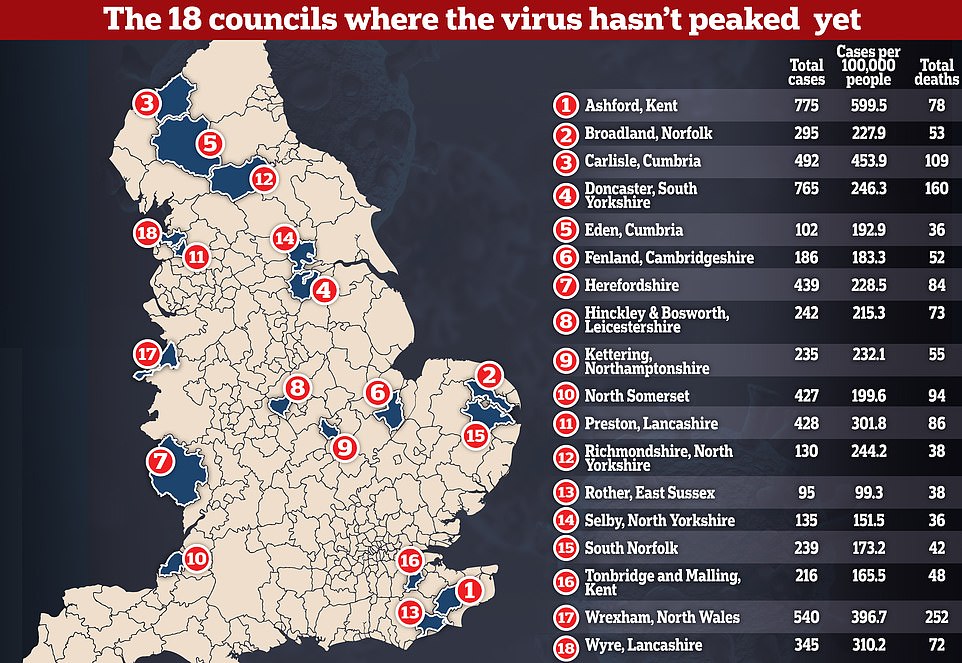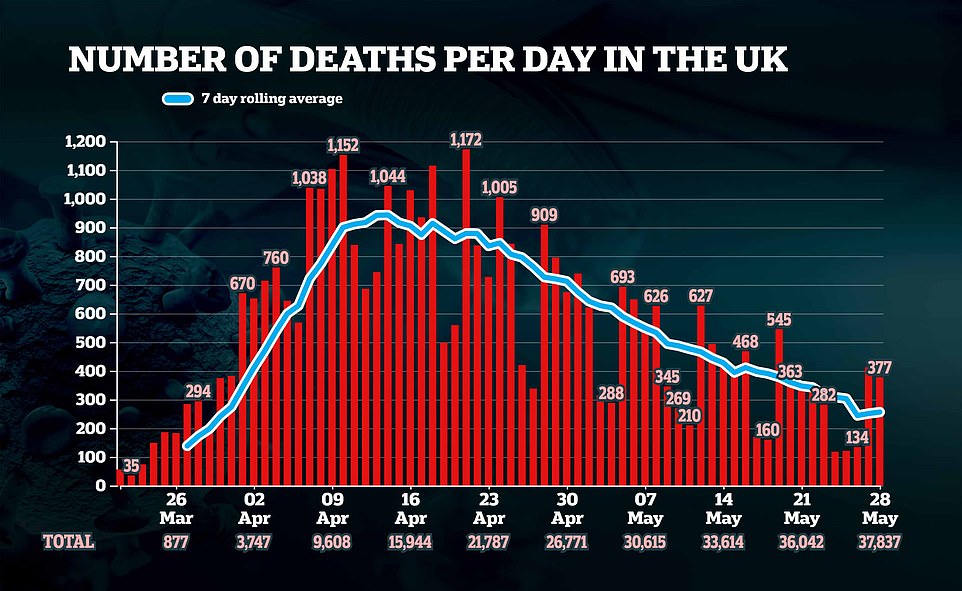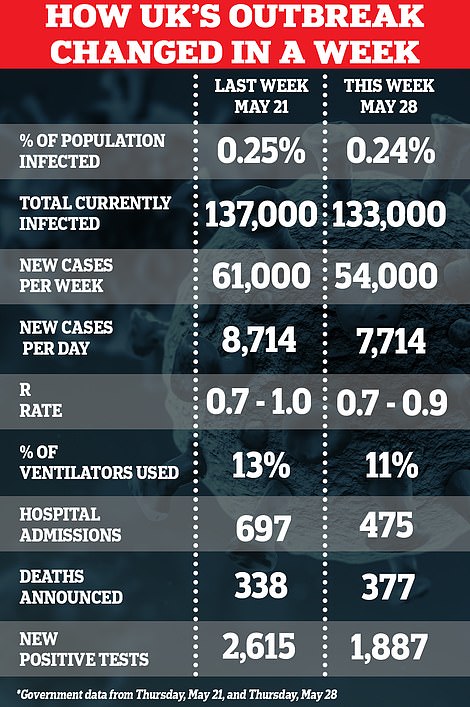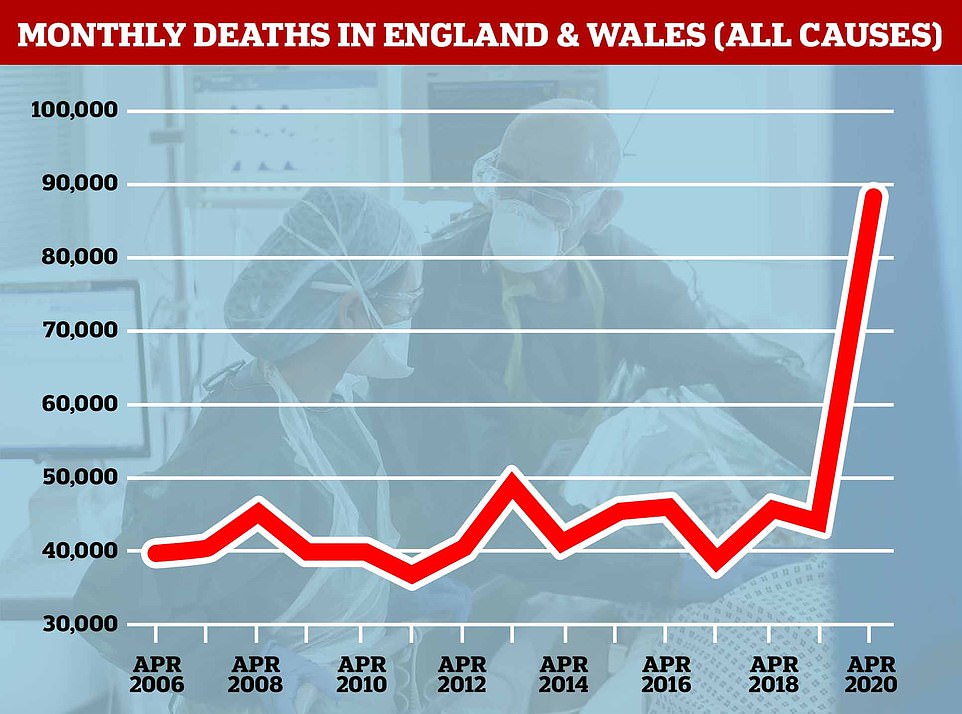How many people have died of Covid-19 in YOUR area? Birmingham has had more than 1,000 coronavirus fatalities – as analysis shows 18 areas in England and Wales have yet to see a peak in deaths
- Eighteen councils in Britain have still not yet seen their coronavirus death peak, it was revealed today
- North Somerset, Preston, Doncaster and Carlisle are enduring their worst weeks, according to the analysis
- Office for National Statistics figures have revealed a considerable degree of variation on a local level
- Here’s how to help people impacted by Covid-19
Government data has revealed an area-by-area breakdown of where the most and fewest people have died of the coronavirus since the outbreak began.
Birmingham is the local authority with the most Covid-19 fatalities in England and Wales, and the only one to have recorded more than 1,000 victims (1,047).
Meanwhile, Leeds, Durham and Liverpool have all recorded more than 500 deaths each since the beginning of the pandemic – 574, 516 and 509, respectively.
Only one local authority has recorded no deaths at all – the Isles of Scilly off the coast of Cornwall, which are home to just 2,000 people.
Office for National Statistics (ONS) data has set out the areas where the most and fewest people have been killed by the virus by May 15, when the total for England and Wales was 41,047.
While the national outbreak is believed to be past its peak, there are 18 areas where Covid-19 fatalities still appear to be on the rise.
Local authorities including North Somerset, Kettering Preston, Doncaster, Wrexham and Carlisle, have yet to suffer their darkest days of the crisis, according to a separate analysis of the ONS data.
North Somerset recorded 24 coronavirus deaths in that week – up from 16 in the seven-day spell before. The area includes Weston General Hospital, which dramatically shut its doors to new patients on Monday following a spike in coronavirus patients.
It comes after Health Secretary Matt Hancock confirmed earlier this week that ‘local lockdowns’ could be imposed on whole towns if there are regional flare-ups of coronavirus cases.

Eighteen councils in Britain have not yet seen their coronavirus death peak and many saw more people die in the week from May 9 to May 15 than at any other point in the outbreak so far. One of them was North Somerset, where Weston-super-Mare had to close its hospital because of a rampant spread of the disease


Most of the deaths recorded in the ONS’s figures happened in hospitals – 26,679 – with the most hospital deaths occurring in Birmingham, where there were 784.
This was followed by the London borough of Brent, with 368.
Meanwhile 11,632 people died in care homes in England and Wales, the biggest proportion of which was the 243 residents who died in County Durham.
The most recent data published by the Office for National Statistics (ONS) shows that 18 local authorities recorded their highest weekly death toll in the seven-day spell that ended May 15.
In Doncaster the number of people dying of the coronavirus has remained relatively stable for the past six weeks and had not started to drop by May 15.
A total of 31 people died in that week, from May 9 to May 15, which was the same as the tally counted a fortnight earlier – and the joint highest so far.
The week before had suggested a drop, with the figure falling from 31 to 18, but it bounced back again showing the area is still battling the virus.
At least half a dozen areas showed the same pattern – a one week drop in fatalities followed by a resurgence – which may have been a result of the VE Day bank holiday on May 8. Statisticians warned that deaths do not get registered properly on bank holidays and the statistics for the weeks surrounding them may be inaccurate.
In a data release the ONS said: ‘The early May Bank Holiday contributed to both the decrease in the number of deaths registered in Week 19 and the increase in the number of deaths registered in Week 20, as deaths were unlikely to be registered on Friday 8 May.
‘Next week’s report will allow a better assessment of recent trends in the number of all-cause deaths and deaths related to COVID.’
Ashford in Kent saw its weekly death toll drop from 14 to eight and then back up to 19 for the week ending May 15 – that was its highest one-week number of the epidemic.
Many of the areas’ record high death tolls could be averaged out with the week before to arrive at a similar figure to recent weeks.
But North Somerset did not follow the same trend. Instead, after weeks of relatively steady death tolls in the mid-teens, its number for the week ending May 15 surged from 16 to 24.
This is likely because the coronavirus outbreak there has worsened in recent weeks. The general hospital in Weston-super-Mare, a seaside town in the district, had to close to new patients this week because of Covid-19.
Infection rates were found to be high in both staff and patients so the hospital shut its doors to new admissions in a desperate bid to get a handle on the crisis.
Workers at the hospital forced to close due to a Covid-19 outbreak were the first to be contacted by the government’s Test and Trace programme today – as it emerged twice as many staff have the virus than patients.
Boris Johnson used Weston Hospital as an instance where the Government ‘moved very quickly to close things down there to try to sort it out’.
He added: ‘That is the kind of whack-a-mole tactics that we are going to use as we keep driving the virus down and keep reducing the incidents.’
The hospital in Weston-super-Mare, Somerset, is believed to have 135 members of staff infected compared to 64 patients.
Those workers were among the 2,013 people who tested positive for the virus on Wednesday and who were contacted as part of the Test and Trace system rolled out across England and Scotland this morning.
The scheme is designed to find anyone who has come into contact with an infected person so they can be told to isolate for 14-days even if they are not sick.
Weston General shut its doors on Monday and is unlikely to admit any new patients for at least another week while it deals with the current outbreak. All members of staff are currently undergoing testing for Covid-19 which is set to be completed by the weekend.
Speaking to the BBC, Robert Woolley, chief executive of University Hospitals Bristol and Weston NHS Foundation Trusts said an investigation was under way to find out the cause of the spike in staff infections.
He said: ‘The question is, have we had patients bringing the infection into hospital when they arrive and staff are getting infected that way?
‘Or are staff coming in from the community infected and infecting themselves and possibly others? We just don’t know.
‘It’s very complex and we need help from other agencies to know what the position is in greater Weston.’
A number of factors behind the spike are being considered, including claims that emerged today of hospital staff not being routinely informed by managers when their colleagues tested positive for the virus – even those who had previously shown no symptoms.
But North Somerset is not alone in terms of high coronavirus deaths.
Those areas yet to see their peak include Ashford, Kent; Broadland, Norfolk; Carlisle, Cumbria; Doncaster, South Yorkshire; Eden, Cumbria; Fenland, Cambridgeshire; Herefordshire; Hinckley and Bosworth, Leicestershire; Kettering, Northamptonshire; and North Somerset.
Other areas are Preston, Lancashire; Richmondshire, North Yorkshire; Rother, East Sussex; Selby, North Yorkshire; South Norfolk; Tonbridge and Malling, Kent; Wrexham, North Wales; and Wyre, Lancashire.
It comes as the Prime Minister tonight gave the green light to the first limited socialising since lockdown, revealing that up to six people can now meet outdoors and in private gardens for barbecues – as long as they stay six feet away from each other.
Mr Johnson revealed that the restrictions are being eased slightly from next week, as he formally reduced the country’s Covid ‘alert’ status from four to three.
Despite warnings from chief scientific adviser Patrick Vallance that 8,000 new infections are still happening every day and admitting making the rules more nuanced will create ‘anomalies and inconsistencies’, Mr Johnson unveiled a series of changes to take effect in England from Monday.
Up to six people from different households will be allowed to mix, opening the prospect of reunions for family and friends – although they will still be told to obey social distancing rules. They will also be permitted to use gardens and private outdoor spaces, which was previously banned.
Non-essential shops and primary schools will start to reopen from next month, as had been suggested earlier in the week.
Mr Johnson told the daily Downing Street briefing: ‘I cannot and I will not throw away all the gains we have made together. So the changes that we have made are limited and cautious.’
It comes after Britons were last night warned not to get carried away with news that lockdown is loosening because the virus’ R-rate is still dangerously close to 1.
The Government’s top scientific adviser Sir Patrick Vallance revealed the current R-rate is between 0.7 and 0.9, and while coronavirus case numbers were declining, they are ‘not coming down fast’ in a downbeat update at tonight’s Downing Street press conference.
The reproduction rate denotes the number of other people an infected patient will pass the sickness on to and it must stay at 1 or below or Britain will face another crisis. However, the way the R is calculated means it is out of date, and the latest calculation is based on data from around three weeks ago – before the lockdown loosened.
‘The current value is somewhere between 0.7 and 0.9, so it remains close to one. It may very close to one in some areas,’ said Sir Patrick. ‘The numbers are coming down at the moment, but they are not coming down fast.’
In separate data released yesterday by the Office for National Statistics shows that around 3.7million people in England have already had coronavirus, a similar estimate to the 17 per cent of Londoners and five per cent elsewhere announced by Matt Hancock last week.
But worryingly, it also revealed that of the people testing positive for Covid-19 in its nationwide scheme, only around one in five actually had symptoms, suggesting that the virus is spreading silently through the population.
The ONS data also showed the progress of the outbreak shrinking is slow and the presence of the virus in the community has dropped only 0.01 per cent in the past week. The body described the outbreak as ‘relatively stable’.
There are still 54,000 new infections happening each week – down from 61,000 per week at the start of May – and 133,000 people are thought to currently have the virus, down from 137,000. This means one in 1,000 people catch it each week. And the coronavirus’s reproduction rate – the R – is now between 0.7 and 0.9, which is slightly lower than last week, when the range was 0.7 to 1.
Explaining that 8,000 people per day are still catching the infection, Sir Patrick said: ‘That is not a low number. So it’s worth remembering that we still have a significant burden of infection. We are still seeing new infections every day at quite a significant rate, and the R is close to 1. That means there is not a lot of room to do things and things need to be done cautiously, step-by-step, and monitored.’
Separate data released today for the first time shows that one in every 14 people (7 per cent) in England – around 3.7million people – have already had coronavirus, according to first published results of its antibody surveillance testing scheme, which found 60 of 885 people whose blood was analysed had Covid-19 specific antibodies.
It suggests 4.5million people across the UK have been exposed to the virus – a similar estimate to the 17 per cent of Londoners and five per cent elsewhere announced last week by Health Secretary Matt Hancock. That would indicate the mortality rate of the virus in the UK, based on a suspected 51,095 deaths, is around 1.14 per cent, meaning one in every 88 coronavirus patients dies.
Worryingly, the ONS revealed that of the people testing positive for Covid-19 in its nationwide scheme, only 21 per cent actually had symptoms at the time their positive sample was taken. This suggests the virus is still spreading silently through the population and potentially tens of thousands of people have no idea they’ve got it.
As a result of the stable outbreak, Boris Johnson has announced lockdown will loosen from next week. People will be able to meet in gardens and parks in groups of up to six, provided they can maintain social distancing. He said people are still not allowed to visit people indoors.
The PM confirmed that schools will start to reopen next week and car showrooms and ‘outdoor retail’ will be able to reopen. Other ‘non-essential’ shops will be allowed to reopen from mid-June, Mr Johnson said, providing there are no signs of the outbreak bouncing back.
The country is now widely considered to be over the worst of the outbreak, and shocking statistics this week showed April was the deadliest month on record in England and Wales.
Data shows 88,153 people died last month across the two countries – more than double the amount recorded last April (44,123) or before the outbreak spiralled out of control in February 2020 (43,653).
The figure, released by the Office for National Statistics (ONS), shows the arrival of Covid-19 on British shores led to people dying at twice the rate they would in a normal month.
In London this effect was even worse, with startling figures showing the number of people who died in April was triple what it was in the same month last year.
Counting people who had coronavirus listed as their official cause of death, the number of fatalities nationwide in April was 27,764. But experts say the true death toll of the infection is considerably higher because many patients will have been undiagnosed or their cause of death inaccurately recorded.
‘Excess deaths’ have also emerged as an issue, with the pandemic leading to people dying of causes other than the virus because they couldn’t get the same medical care they would have otherwise had access to.

The number of people dying in April each year has remained relative stable at around 40,000 or the last 13 years, but saw a massive spike to 88,000 this year as the coronavirus epidemic raged through the UK
The ONS statistics published yesterday showed the number of people who have died of any cause, month by month.
In January this year, 56,706 people died in England and Wales, which was high but not unheard of for winter. That was followed by 46,653 in February and 49,723 in March.
April, however, brought a huge spike to 88,153 – 0.15 per cent of the entire population.
The first death from coronavirus in an NHS England hospital happened on March 2 and there were 3,857 during that month. There were 17,774 in April.
Regionally the biggest increase in deaths between April last year and April this year happened in London, where it rose 197 per cent from 4,102 to 12,175.
It also more than doubled in the West Midlands, which is centred around Birmingham, from 4,527 to 9,932 (119 per cent).
And in the North West, including Lancashire, Cumbria and Manchester, it rose by 112 per cent from 5,835 to 12,354.
Other regions of the country saw substantial increases but their numbers less than doubled.
The absolute most deaths happened in the South East, which includes Surrey, Hampshire and Kent, where 12,823 people died in April. This was a 90 per cent increase on 6,765 people in April 2019.
Some areas were hit significantly harder than others, the data shows, with the London borough of Haringey experiencing the biggest rise in deaths between April 2019 and 2020. Fatalities there rose from just 80 in April 2019 to 353 during the height of the coronavirus pandemic – a surge of 341 per cent.
Newham, in east London, also recorded a more than four-fold rise in deaths, increasing 328 per cent from 95 to 407.
Nine out of 10 of the areas with the biggest increases in people dying were in London – Haringey (341 per cent), Newham (328 per cent), Brent (289 per cent), Enfield (257 per cent), Lewisham (255 per cent), Waltham Forest (248 per cent), Barnet (243 per cent), Redbridge (243 per cent) and Harrow (239 per cent).
Third worst after Newham was Hertsmere in Hertfordshire, where the number of deaths rose from 70 to 278 (297 per cent).
